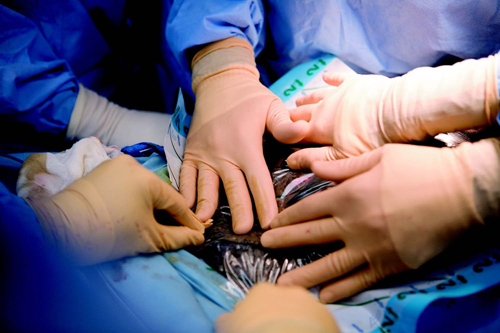Information on the surgical therapy of The surgical therapy of melanoma has a dual purpose: diagnostic and prognostic. The margin of healthy skin to be removed is defined according to the staging of the melanoma.

Stage 0: melanoma in situ: the tumor is removed with a margin of healthy skin of 0.5 cm
Stage I: the melanoma is removed with a margin of healthy skin which depends on the thickness of the tumor:
Thickness < 1 mm: 1 cm of healthy skin
1 to 2 mm thick: 1 to 2 cm of healthy skin routine removal of satellite lymph nodes is not performed, lymph node dissection is recommended if the melanoma is stage IB and has features suggestive of lymph node dissemination. In all ways, the presence of distant metastases must be excluded
Stage II: Thickness from 2.1 to 3.0 the margin of healthy skin must be 3 cm. A sentinel lymph node is performed and in case of positivity the satellite lymph nodes must be removed. If the tumor is more than 4 mm thick or if the sentinel lymph nodes are positive, medical therapy is recommended
Stage III: 3.1 and 4.0 mm thick: excision with a wide margin of at least 3 cm, regional lymph node dissection and medical therapy. For limb melanomas, a therapeutic option may be limb perfusion with heated chemotherapy solution (Melphalan). If many lymph nodes are involved, postsurgical radiotherapy can also be performed. All other medical treatments (immunotherapy, cytokines etc) can be performed
Stage IV: tumors that are difficult to treat because there are lymph node and distant metastases. The primary tumor must be removed with a wide margin, satellite or distant skin tumors must be surgically removed and the regional lymph nodes removed. Symptomatic metastases that cannot be removed should be treated with medical or radiation therapy
Relapsing melanoma: if the melanoma relapses in the scarring site of the primary melanoma, it is necessary to perform a wide excision with the possible removal of the regional lymph nodes if it has not been performed in the previous operation. In the case of distant local recurrence of the scar or in the case of satellitosis or recurrences in transit, excision and any sentinel lymph node must be performed. If we have a lymph node recurrence it is necessary to remove the residual lymph nodes. Medical therapy is therefore recommended as for stage IV. Distant melanoma metastases: they can be removed with surgery, laser, electrochemotherapy.
Lentigo maligna melanoma: due to the fact that the limits are ill-defined and that there is often atypical lymphocyte proliferation several centimeters beyond the visible margin, recurrences are often frequent (above 50%); for surgery there are no specific rules, the edge of the lesion is often identified with dermoscopy or Wood’s light. Sometimes an incisional biopsy is performed before excision or Mohs surgery (used only in some centers) can be a useful method.
Experimental therapies: some forms of in situ melanoma of the lentigo maligna type were treated with Imiquimod (Aldara) cream, other surgeons used Aldara in the three months following the treatment which led to a reduction in local recurrences.
Bibliography
1. Miller AJ, Mihm MC. Melanoma. N Engl J Med 2006;355(1):51-65.
2. Korn EL et al. Meta-analysis of phase II cooperative group trials in metastatic stage IV melanoma to determine progression-free and overall survival benchmarks for future phase II trials. J Clin Oncol 2008;26(4):527-34.
3. Dummer R, Hauschild A, Jost A. Cutaneous malignant melanoma: ESMO clinical recommendations for diagnosis, treatment and follow-up. Ann Oncol 2008;19 Suppl 2:ii86-8.
4. AJCC. American Joint Committee on Cancer Staging Sixth Edition. 2008 [cited 2008 December 2008]; Available from: https://www.cancerstaging.org/education/smmelanomastagingschema.ppt
5. Hodi FS, Granter S, Antin J. Withdrawal of immunosuppression contributing to the remission of malignant melanoma: a case report. Cancer Immun 2005;5:7.
6. Breslow A. Thickness, cross-sectional areas and depth of invasion in the prognosis of cutaneous melanoma. Ann Surg 1970;172(5):902-8 .
7. MD Anderson Cancer Center Guidelines for melanoma treatment, July 2005.
8. NCCN. NCCN Practice Guidelines in Oncology – V.1.2009. Melanoma 2008.
9. Hauschild A et al. Practical guidelines for the management of interferon-alpha-2b side effects in patients receiving adjuvant treatment for melanoma: expert opinion. Cancer 2008;112(5):982-94.
10. Eggermont AM et al. Adjuvant therapy with pegylated interferon alfa-2b versus observation alone in resected stage III melanoma: final results of EORTC 18991, a randomized phase III trial. Lancet 2008;372(9633):117-26.
11. Ascierto PA. Kirkwood JM. Adjuvant therapy of melanoma with interferon: lessons of the past decade. J Transl Med 2008;6:62.
12. Gogas HJ, Kirkwood JM, Sondak VK. Chemotherapy for metastatic melanoma: time for a change? Cancer 2007;109(3):455-64.
13. Grob JJ et al. Randomized trial of interferon alpha-2a as adjuvant therapy in resected primary melanoma thicker than 1.5 mm without clinically detectable node metastases. French Cooperative Group on Melanoma. Lancet 1998;351(9120):1905-10.
14. Pardoll D. T cells take aim at cancer. Proc Natl Acad Sci USA 2002;99(25):15840-2.
15. Armstrong AC, Eaton D, Ewing JC. Science, medicine, and the future: Cellular immunotherapy for cancer. BMJ 2001;323(7324):1289-93.
16. Finn OJ, Cancer immunology. N Engl J Med, 2008;358(25):2704-15.
17. Weiner LM. Cancer immunotherapy – the endgame begins. N Engl J Med 2008;358(25):2664-5.